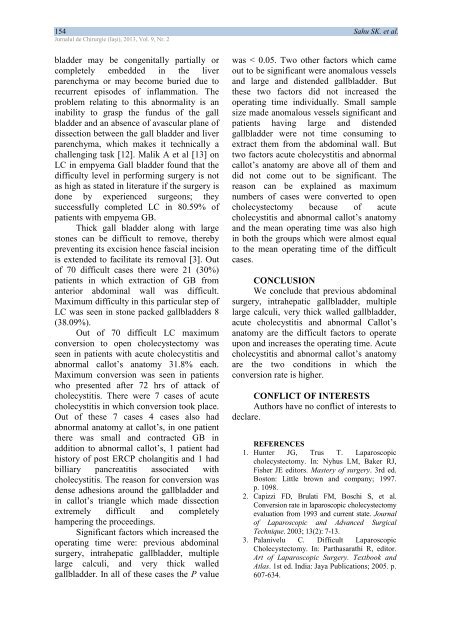PDF (5 MB) - Jurnalul de Chirurgie
PDF (5 MB) - Jurnalul de Chirurgie
PDF (5 MB) - Jurnalul de Chirurgie
You also want an ePaper? Increase the reach of your titles
YUMPU automatically turns print PDFs into web optimized ePapers that Google loves.
154 Sahu SK. et al.<strong>Jurnalul</strong> <strong>de</strong> <strong>Chirurgie</strong> (Iaşi), 2013, Vol. 9, Nr. 2blad<strong>de</strong>r may be congenitally partially orcompletely embed<strong>de</strong>d in the liverparenchyma or may become buried due torecurrent episo<strong>de</strong>s of inflammation. Theproblem relating to this abnormality is aninability to grasp the fundus of the gallblad<strong>de</strong>r and an absence of avascular plane ofdissection between the gall blad<strong>de</strong>r and liverparenchyma, which makes it technically achallenging task [12]. Malik A et al [13] onLC in empyema Gall blad<strong>de</strong>r found that thedifficulty level in performing surgery is notas high as stated in literature if the surgery isdone by experienced surgeons; theysuccessfully completed LC in 80.59% ofpatients with empyema GB.Thick gall blad<strong>de</strong>r along with largestones can be difficult to remove, therebypreventing its excision hence fascial incisionis exten<strong>de</strong>d to facilitate its removal [3]. Outof 70 difficult cases there were 21 (30%)patients in which extraction of GB fromanterior abdominal wall was difficult.Maximum difficulty in this particular step ofLC was seen in stone packed gallblad<strong>de</strong>rs 8(38.09%).Out of 70 difficult LC maximumconversion to open cholecystectomy wasseen in patients with acute cholecystitis andabnormal callot’s anatomy 31.8% each.Maximum conversion was seen in patientswho presented after 72 hrs of attack ofcholecystitis. There were 7 cases of acutecholecystitis in which conversion took place.Out of these 7 cases 4 cases also hadabnormal anatomy at callot’s, in one patientthere was small and contracted GB inaddition to abnormal callot’s, 1 patient hadhistory of post ERCP cholangitis and 1 hadbilliary pancreatitis associated withcholecystitis. The reason for conversion was<strong>de</strong>nse adhesions around the gallblad<strong>de</strong>r andin callot’s triangle which ma<strong>de</strong> dissectionextremely difficult and completelyhampering the proceedings.Significant factors which increased theoperating time were: previous abdominalsurgery, intrahepatic gallblad<strong>de</strong>r, multiplelarge calculi, and very thick walledgallblad<strong>de</strong>r. In all of these cases the P valuewas < 0.05. Two other factors which cameout to be significant were anomalous vesselsand large and disten<strong>de</strong>d gallblad<strong>de</strong>r. Butthese two factors did not increased theoperating time individually. Small samplesize ma<strong>de</strong> anomalous vessels significant andpatients having large and disten<strong>de</strong>dgallblad<strong>de</strong>r were not time consuming toextract them from the abdominal wall. Buttwo factors acute cholecystitis and abnormalcallot’s anatomy are above all of them anddid not come out to be significant. Thereason can be explained as maximumnumbers of cases were converted to opencholecystectomy because of acutecholecystitis and abnormal callot’s anatomyand the mean operating time was also highin both the groups which were almost equalto the mean operating time of the difficultcases.CONCLUSIONWe conclu<strong>de</strong> that previous abdominalsurgery, intrahepatic gallblad<strong>de</strong>r, multiplelarge calculi, very thick walled gallblad<strong>de</strong>r,acute cholecystitis and abnormal Callot’sanatomy are the difficult factors to operateupon and increases the operating time. Acutecholecystitis and abnormal callot’s anatomyare the two conditions in which theconversion rate is higher.CONFLICT OF INTERESTSAuthors have no conflict of interests to<strong>de</strong>clare.REFERENCES1. Hunter JG, Trus T. Laparoscopiccholecystectomy. In: Nyhus LM, Baker RJ,Fisher JE editors. Mastery of surgery. 3rd ed.Boston: Little brown and company; 1997.p. 1098.2. Capizzi FD, Brulati FM, Boschi S, et al.Conversion rate in laparoscopic cholecystectomyevaluation from 1993 and current state. Journalof Laparoscopic and Advanced SurgicalTechnique. 2003; 13(2): 7-13.3. Palanivelu C. Difficult LaparoscopicCholecystectomy. In: Parthasarathi R, editor.Art of Laparoscopic Surgery. Textbook andAtlas. 1st ed. India: Jaya Publications; 2005. p.607-634.
















